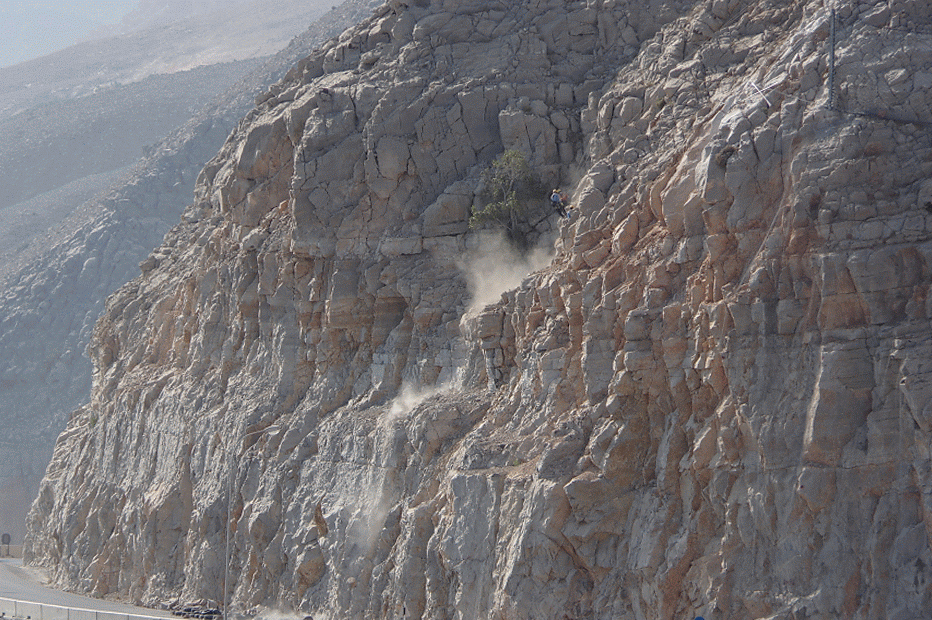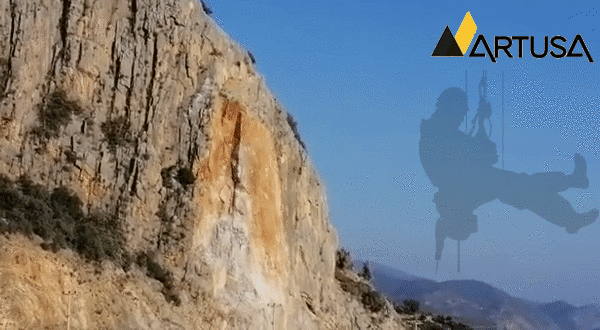
Rock scaling generally refers to the removal of loose rocks or blocks on a slope but also includes the removal of loose debris as well as bushes and trees. This process is done by removing loose surface material presenting a rockfall hazard, usually with pry-bars and similar hand tools. Where large sections of rock or large boulders require removal, a variety of techniques can be utilized including winching, airbags or pillows, and breaking up in situ using power tools. Rock Scaling is safest and most effective when done considering rope access techniques. It is generally the first step in all rock stabilization jobs to make it safe to proceed with drilling or other required stabilization measures. However, scaling can be an individual slope stabilization measure as well. Nevertheless, it is often performed as an initial process in a slope stabilization project, as rock scaling alone is considered a temporary solution. Manual rock scaling is superior to mechanical or demolition scaling because it addresses individual rocks and does not destabilize the entire slope. However, trim blasting can also be used to remove larger rock features or mass.
Scaling is usually required on rock cuts above highways, railways, walking trails, hydropower plants, on high walls of open-pit mines and quarries, and on other structures. Some slopes require regular scaling, while others may be good for many years after a thorough scaling. Certain slopes may be stabilized through scaling alone, while others may require more extensive stabilization measures such as rock bolting, slope mesh netting, blasting or shotcrete.
Our use of rope access techniques as well as certified rope access technicians is how we increase safety. Each technician should be trained in rope access and rope rescue and is equipped with the necessary equipment to perform a rope rescue in case of emergency. Artusa employs some of the best rock rope access technicians in the industry and can respond to emergency situations asap.

causes of rock falls, Rock slope stabilization programs, Planning stabilization programs, Rock slope inventory systems, Hazard rating criteria, Database analysis of slope inventory, Selection of high priority sites, Selection of stabilization measures, Stabilization by rock reinforcement, Shear keys, Rock anchor, Reaction wall, Shotcrete, Buttresses, Drainage, Shot-in-place buttress, Stabilization by rock removal, Resloping and unloading, Trimming, Scaling, Rock removal operations, Protection measures against rock falls, Rock fall modeling, Ditches, Barriers, Rock catch fences and attenuators, Draped mesh, Warning fences, Rock sheds and tunnels, Types of slope movement, Initial response, Regressive and progressive movement, Long-term creep, Surface monitoring methods, Crack width monitors, Surveying, Laser imaging, Tiltmeters, Global positioning system, Synthetic aperture radar, Sub-surface monitoring methods, Borehole probes, Time–domain reflectometry, Inclinometers, Data interpretation, Time–movement and time–velocity plots, Slope failure mechanisms, Rock Slope Protection, Slope Roughening, Terracing, and Rounding, Mulches, Erosion Control Blankets, Mats, Anchor Block Slope Stabilization, Anchors, Gabions, Micropile Slide Stabilization System, Sculpted Shotcrete, Secant or Tangent Piles, Sheet Piles, Slurry Walls, Soil Nailing, Soldier Piles, Lagging, Buttress support, Meshing, Netting, rockfall barriers, Geobrugg, Oman, GCC, Ghana, Turkey, contractor, Soil Slope Collapse, Rock Slope Collapse, Landslide, Road Slip, Debris Flow, River Erosion, Coastal Erosion, Road Slope Disasters, rockfall protection, slope stabilisation, rock bolting, rock scaling, rope access, rockfall mesh, steel grid netting, drill and blast, high tensile mesh

